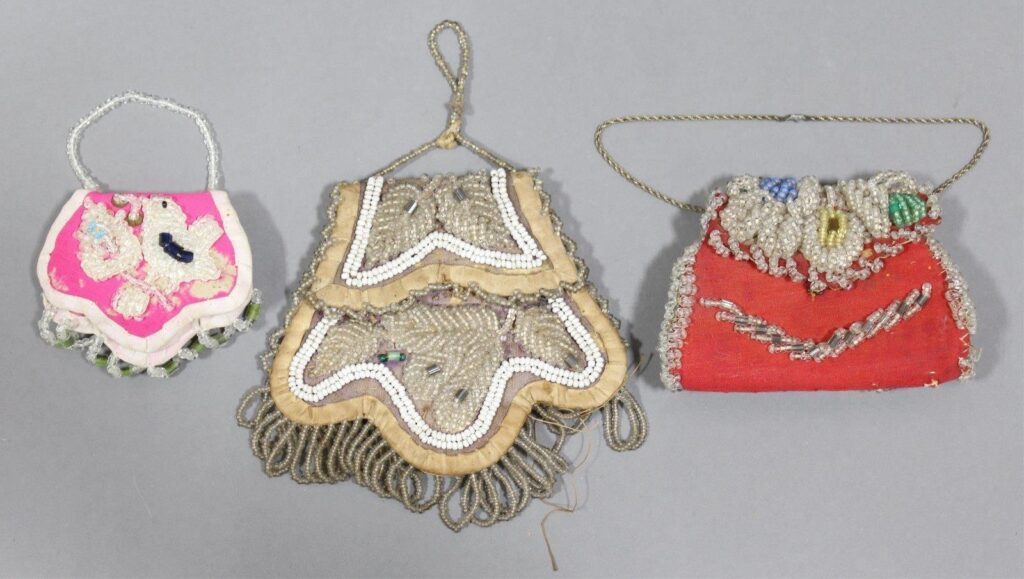Iroquois Purses
Iroquois Purses
By Dolores Elliott
Multicolored beaded flat purses are the most common form of Iroquois beadwork. They are easily recognized because they have brightly colored flowers beaded on both sides, and both sides are usually identical or very similar. At least ten different colored beads are usually used in two shades of five different colors: pink/red, yellow/amber, bright blue/ light blue, dark green/light green, white/clear. Almost all the purses have all the colors. The shades of the color vary, but they almost always have flowers in those colors. Most people, Indian and not, recognize these purses as being Iroquois-made.
These purses were made from the second quarter of the 19th century until the end of that century. The majority of these purses are so similar it might be thought that one person made them all, but that is not likely as they were made over a period of 75 years. It is estimated that over ten thousand of these purses were made. But if one person did not make them all, and no identical purses have been observed, how can they be so similar?
These flat purses are made by cutting four pieces of cardboard or heavy paper for the body and the flaps. Either black or dark brown velvet is attached to the backing. The design is beaded on to each of the four pieces. Flowers often have paper patterns so the needle had to penetrate three layers: the pattern, the velvet, and the stiffening material (thick paper, double newsprint, or cardboard).
The two body pieces and the two flaps are usually beaded with almost identical designs on each side of the purse. Each flap is lined with polished cotton and is attached to the top of the body piece. Then a fabric lining is sewn over the backing on the inside of the purse pieces. This lining covers up the stitches on the back of the beading. Then the two bodies with flaps attached are sewn together around the whole body, except for across the top, which is left open. Unless the purse is attached to a metal handle, there is no way to close the mouth of the purse. Sometimes a small slit is cut into the velvet under one of the flaps. The slit is lined and attached to a small pocket that some people think was meant to store a comb. A binding is sewn onto the edges of the purse body to cover the edges of each side. The binding is usually red but it is sometimes green, blue, or black.
A binding, which is often a delicate silk, is also sewn across each side of the mouth. It is usually a different binding than that used around the body of the purse.
Some purses are also decorated by a beaded fringe along the edge of the purse, attached to the binding. The fringe is often made of loops of smaller beads than the ones used on the faces of the purse. The edges of the flaps are also beaded but often with beads larger than the ones used on the rest of the purse. This is most obvious on the flaps where the beads outlining the flaps are almost always smaller than the beads that outline the flaps. Both sides of the purse are identical or almost identical with only small variations in bead color placement.
There are five basic shapes of these bags. Some are the urn-shaped, some hexagon-shaped, some rocker-shaped, some scalloped, and some the classic-shape. The classic shaped bag is the most common. Sometimes the beadwork is attached to a larger silk bag to make the purse look more elegant, as a ribbon handle and bead fringe make a pretty purse.
It is rare to find a purse with two flaps on each side, but there are some. There are also some purses that have no flap but only a line of beads indicating where a flap would be. A few purses have metal closures across the mouth. Some appear to be homemade, perhaps on the reservation. Others appear to be commercial closures made out of a stamped metal.
Antique sellers and museum provenience records sometimes identify these bags as “probably Tuscarora,” but I think that they were more likely made by Mohawk bead workers. One reason is that in at least one purse the paper stiffening is a French language Montreal newspaper. Montreal is close to three Mohawk reservations. Another reason is that just as on the purses, the Mohawks preferred the repeated four-color motif on their pincushions and picture frames. The purses almost always used this color scheme. One type of purse that features bird-like images is frequently identified as Tuscarora-made, claiming that the birds are images of Carolina parakeets that the Tuscaroras left in their homes when they moved north to join the Iroquois Confederacy. I think this is a recently created myth and that all of these purses were made by Mohawk bead workers.
There are several photographs of women selling beadwork at Niagara Falls, and others showing people selling Mohawk beadwork. There are no floral purses included in the photographs. So, the photos do not help us to discover where the purses were made. Maybe we will never know.
WorthPoint: Get the Most from Your Antiques & Collectibles



